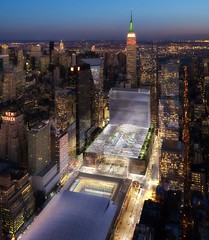 As the Tishman Speyer deal for the Hudson Yards collapsed completely on Tuesday, tempers have flared over the fate of development along the West Side. In one corner, we have Sen. Chuck Schumer fighting for Moynihan Station and office space in and around Penn Station. In the other corner, we have Mayor Mike Bloomberg, 18 months away from heading out of office and in search of a lasting New York City legacy.
As the Tishman Speyer deal for the Hudson Yards collapsed completely on Tuesday, tempers have flared over the fate of development along the West Side. In one corner, we have Sen. Chuck Schumer fighting for Moynihan Station and office space in and around Penn Station. In the other corner, we have Mayor Mike Bloomberg, 18 months away from heading out of office and in search of a lasting New York City legacy.
The stakes in this political death match are high: They start with the 7 train extension and end with nothing short of a radical alteration of the Manhattan landscape west of Midtown. How it will end is anyone’s guess, but with Tishman Speyer out and the MTA back in negotiations with other potential Yards suitors, the battle has just begun.
The troubles started when talks between the MTA and Tishman Speyer collapsed late last week. While the Bloomberg administration put pressure on the two groups to keep trying this week and even promised to have the city cover the cost overruns for the 7 extension — but not necessarily that controversial station at 41st and 10th Ave. — things died for good today.
With this development, Schumer, long skeptical of the 7 line funding, took this opportunity to push for a project that he considers to be more viable than the Hudson Yards plans. Speaking on Monday at a Crain’s Business Forum, Schumer renewed his calls for Penn Station-focused development:
Mr. Schumer, in laying out his vision for the area at a Crain’s Breakfast Forum, said the mayor should stop funding a $500 million boulevard on the far West Side and instead build a second subway station on the extension of the No. 7 line. (Emphasis added.)
The Metropolitan Transportation Authority’s push for a 16-million-square-foot project at Hudson Yards, strongly encouraged by the city, suffered a setback last week when talks with its chosen developer, Tishman Speyer, broke down. Although Mr. Schumer said, “I am enthusiastic about Hudson Yards,” he said no one would build office space there until the No. 7 extension is in place.
Instead, he said, government should push for more office space by Penn Station, which has one-sixth as much as the Grand Central Terminal area despite serving more commuters.
Schumer and I are on the same page in regards to the 7 line extension, but Schumer and the Mayor disagree over the role of the Port Authority. The Senior Senator from New York would have the Port Authority assume control of this plan. Bloomberg, meanwhile, will have none of it because the Port Authority can’t even seem to get its act together in Lower Manhattan. It’s a grand ol’ political war of words.
On the MTA front, the agency will in all likelihood push hard to wrap up a deal with another suitor. They need the money for their capital budget, and Charles Bagli at City Room reported that Douglas Durst, Stephen Ross and Steven Roth, three other developers interested in the space, are now back on the table. While Durst would have once offered up just $39 million less than Tishman Speyer, that figure is sure to drop, leaving many to wonder why no one raised red flags with Tishman’s offer before it was accepted. The demands that eventually quashed the talks were not new.
Photo of Moynihan Station via Moynihan Station on flickr.

1 comment
Unfortunately, all of these grandiose plans, whether “Moynihan Station” supposedly resuscitating the demolished glory of Penn Station, the Atlantic Yards-Nets-Ratner Brooklyn project, or the Castles-In-The-Sky over the West Side Yards share one significant function: They transfer Public Transportation assets to politically-connected private developers, returning transit improvements in the form of lavish lip service to actual transportation needs.
None of the projects are anything but suburban-style shopping malls topped with skyscrapers, profiting from the transit passengers that will inevitably funnel to & from them, and providing no real long-term transit benefits. They provide no actual transportation benefits.
The #7 extension is nothing more than a stub-end conveyor, a publicly-funded gift to the eventual W.Side developmer. Existing trackage at that site already goes to all four points of the compass, but it has never been integrated to provide the rational transportation that is possible. West Midtown has languished for decades, not because it lacked development (the Javits Center White Elephant was supposed to spark a renaissance 25 years ago), but because mass transit in that neighborhood was better 100 years ago.
Penn Station, the West Side Yards and Amtrak’s Empire Connection (the former NY Central West Side Improvement) are the keystones to one-seat rides to and from Lower Manhattan and Metro-North’s Hudson & New Haven Lines and the entire LIRR System (as well as connections to NJT & Amtrak). Rail connections to Downtown could have been made part of the Route 9 Reconstruction and Amtrak’s Empire Connection (and might’ve even included parts of the High Line -!- ) a decade ago, but each project was – and is – instead seen as discrete and individual, instead of as a part of a regional transportation and economic network.
Short-sighted speculative real estate development focuses only on maximizing bulk and short-term finances, instead of considering the synergistic benefits of the true integration of transportation and real estate development for the regional economy.